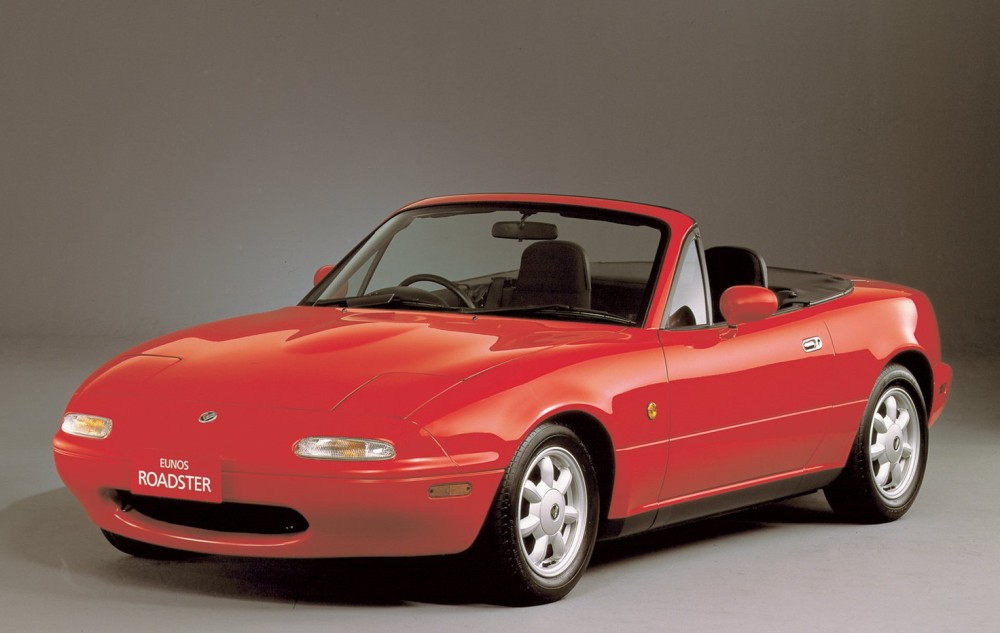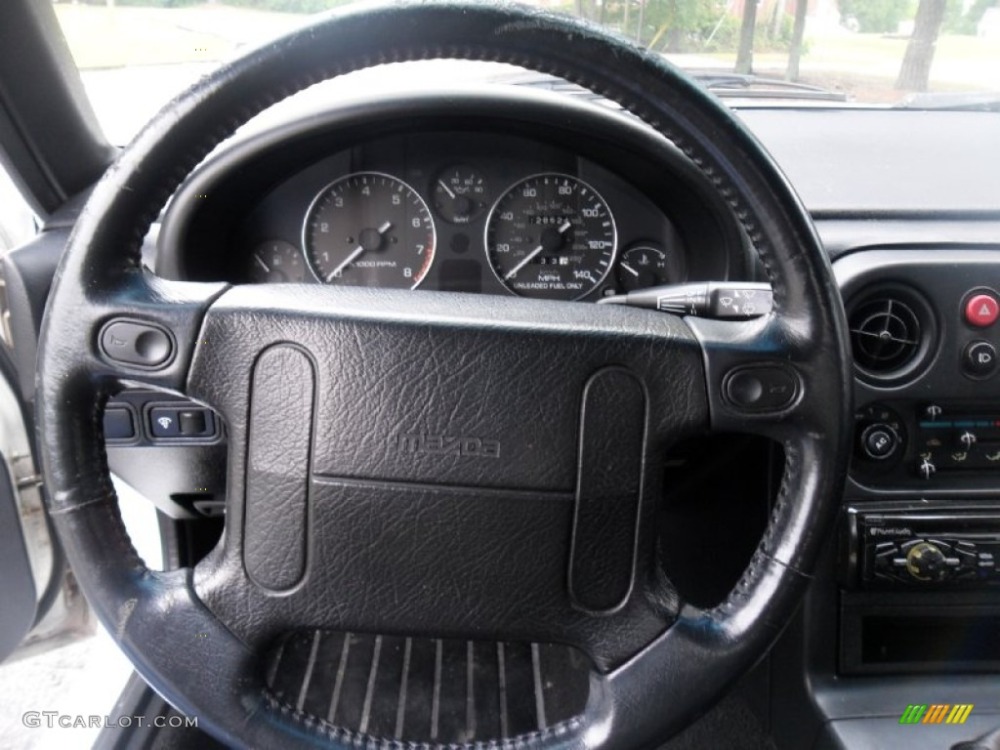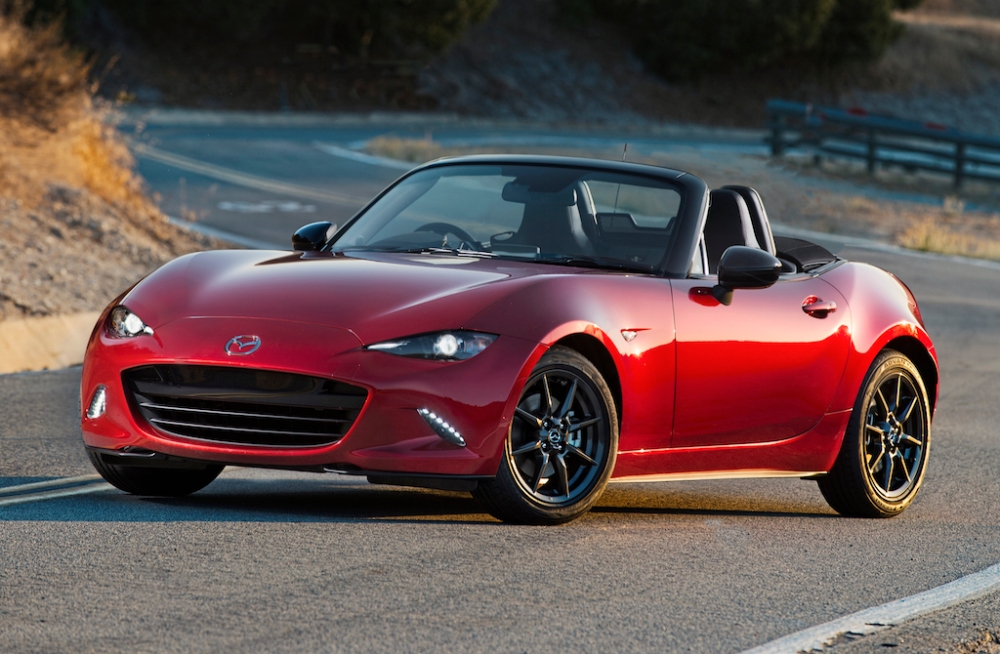I’m the proud owner of a 1993 Mazda Miata. This car is not only my daily driver, but also my ongoing project. It sparked my curiosity when car shopping because I wanted a car that would be reliable, easy to maintain, as well as a good platform to work on. I’m self-taught when it comes to cars and by no means am I saying that I’m a certified mechanic or automotive designer. I can say for sure that I’m an automotive enthusiast and that I want to exercise my knowledge with one of my passions. In this case study, I will talk about my experience as a user/driver with my car as well as analyze the recently released Mazda MX-5 Miata and their comparison.
First generation

My car is the first generation of the now four models of the Mazda Miata. It was inspired by British ‘Roadster’ cars which are defined as as “open two-seat car with emphasis on sporting appearance or character.” To this day, the Mazda Miata is the best-selling two-seat convertible sports car in history. Although it did not produce a great amount of power (~116hp) it made it up with a lightweight body. The power-to-weight ratio in the design resulted in a ‘nimble’ feel for the driver. Sure, having a fast car with a giant engine is fun, but the Mazda Miata was fun in it’s own way. It’s never fun to have a fast sports car that couldn’t be utilized to it’s full potential. With the Miata, the driver would be able to experience the full limits of the vehicle’s performance without having to go to the race track. This was how Mazda gained such great success with the Miata-it was the affordable sports car for the average consumer.
The design

The Mazda Miata is design to be very compact. It has only 2 seats and the driver has easy access to all of the controls of the car. My first few weeks with the car took some adjusting. I wasn’t used to having everything so close-by. Having driven this car four about 3 years, I now understand the advantages of everything being so near. I’m 5’8 with a medium build and everything feels very comfortable to me now. If I lean over, I’m able to open the passenger side door. Putting the convertible top down is easy to do as well because it’s right above and behind me. The climate controls are simple and make sense. They follow the standard iconography found in most other automobiles.
The gauge cluster consists of (from left to right) the fuel gauge, tachometer, oil pressure gauge (top), engine status indicator (bottom), speedometer and engine temperature gauge. I really admire this design because it tells me everything that I need to know. The oil pressure gauge is actually a plus because most standard cars don’t have one. It makes the Miata feel more like a racecar! I believe that this was effective for Mazda because in the 80’s, the trend was to create futuristic vehicles. There was an appeal back then for digital displays and the like. The use of analog and physical controls attribute to the ‘true driving feel.’

The steering wheel is one of my gripes with the design of the car. It feels clunky, and looks like a weird and stretched, “H.” The reason for this is to make space to the airbag. I also disliked the horn on the stock steering wheel. The horn is identified by two buttons on the ends of the steering wheel. Other automobiles use the center of the wheel in order to activate the horn. The buttons on the steering wheel have proved to be a nuisance in my experience because I find myself sometimes pressing the button when making turns. This is especially embarrassing when in parking lots because passerbys think that I have some sort of problem with them.
Overall, the experience is very authentic. Especially without the power steering option, the Miata allows the user to feel very connected to the road. There’s a sense of the ‘racecar’ experience not only due to the performance characteristics but also the feel of being in the driver’s seat. When taking a spirited drive, all controls are easy to access, the information for the user is clearly displayed and the user is snug and secure in the driver’s seat to fully experience the fun that the Miata provides.
Community
I’d like to talk about the Mazda Miata community. Mazda has sold over 900,000 Miatas (all generations) and this resulted in a great gathering of Miata enthusiasts around the world. If I’m working on my car and have a question or issue, I can search it up and find an abundance of forums where other owners share their knowledge. This is what makes owning a Miata so great. There is an abundance of resources available and write-ups made by fellow owners dedicated for tackling projects or issues. Having such a great community has also helped in identifying the common problems found in Miatas which is great for an owner that wants to be prepared. New buyers can also prepare by researching the attributes associated with each generation of the Miata so that the buyer can make the right choice.
2016 Mazda MX-5 Miata

This is the latest generation Mazda Miata. With this model, Mazda aimed to go back to their roots and design the car in a way closest to the first generation Mazda Miata. The weight of the car is slightly higher than the first generation and the idea of a nimble 2-seater convertible sports car is preserved. The styling is very aggressive and this is to stand out against it’s competition, the Subaru BRZ/Scion FRS/ Toyota FT86. Looking at this current generation of vehicles, the styling is very aggressive and ‘angry’ looking.
This current generation Miata is the fastest compared to it’s older brothers (as expected). Mazda kept the formula and didn’t add anything like a turbocharger (which Miata fans were hoping for) to break the cohesiveness of the ongoing design. This was a design decision for Mazda to appeal to the purists.
I recall that during the build-up of the reveal, Mazda used the hashtag #longlivetheroadster to attract attention. This obviously was a way for Mazda to capture the die-hard Miata fans and I’m sure Mazda is well aware of their admirers. I see this as an effective design decision to make sure the fans stay happy as well as appeal to non-enthusiasts with the modern and aggressive styling.

When I look at the cockpit, I’m immediately reminded of the first generation design. Everything is close together in a modern and updated way. The look and visual design exudes a premium feel. Mazda was able to retain the basic original design and modernize it with standard technology to make it a worthy competitor against other sports cars while staying familiar to an older generation owner.
In conclusion, I believe that Mazda did very well with their flagship roadster in multiple ways. They capitalized on their support from loyal fans while creating a vehicle that can still appeal to the average consumer interested in buying a sports car. The starting price is at a reasonable $25,000 and what the driver will get out of it is an experience unlike the rest.
#longlivetheroadster
My Miata:

Sources:
http://www.edmunds.com/mazda/mx-5-miata/history/
https://en.wikipedia.org/wiki/Roadster_(automobile)
